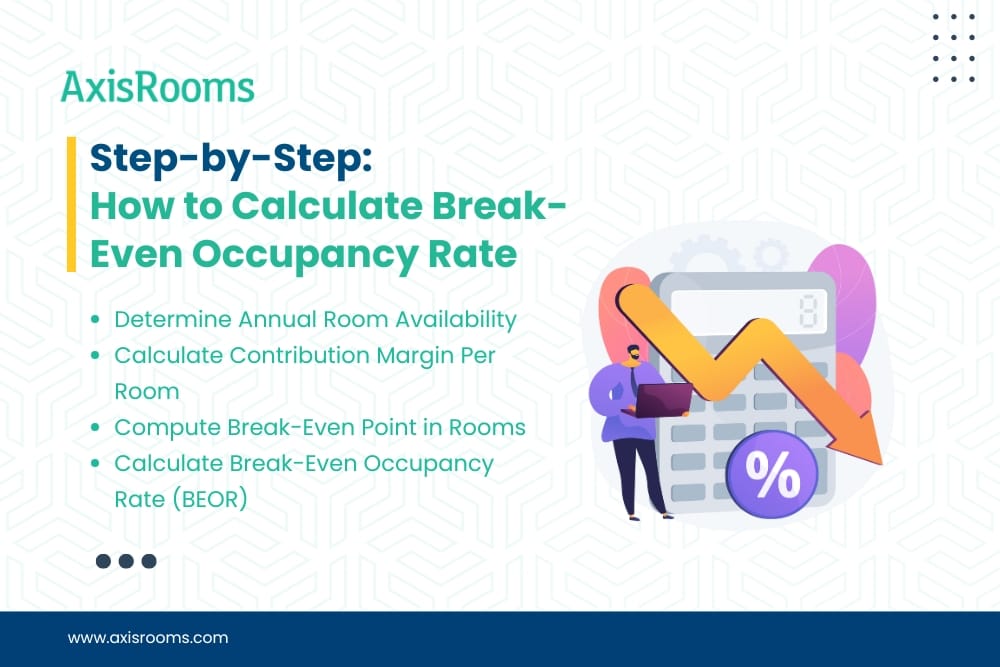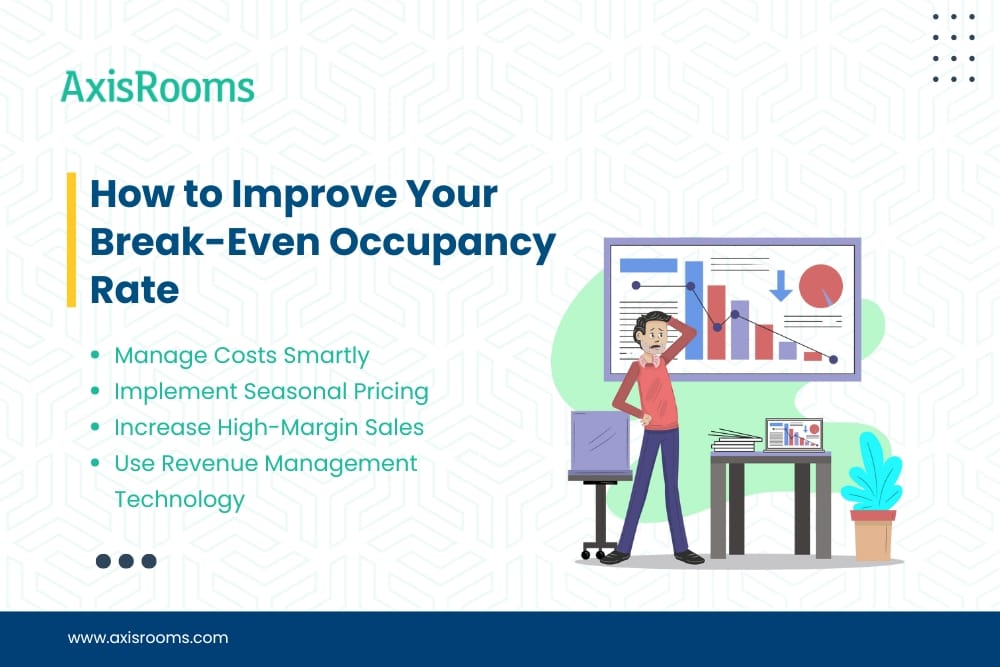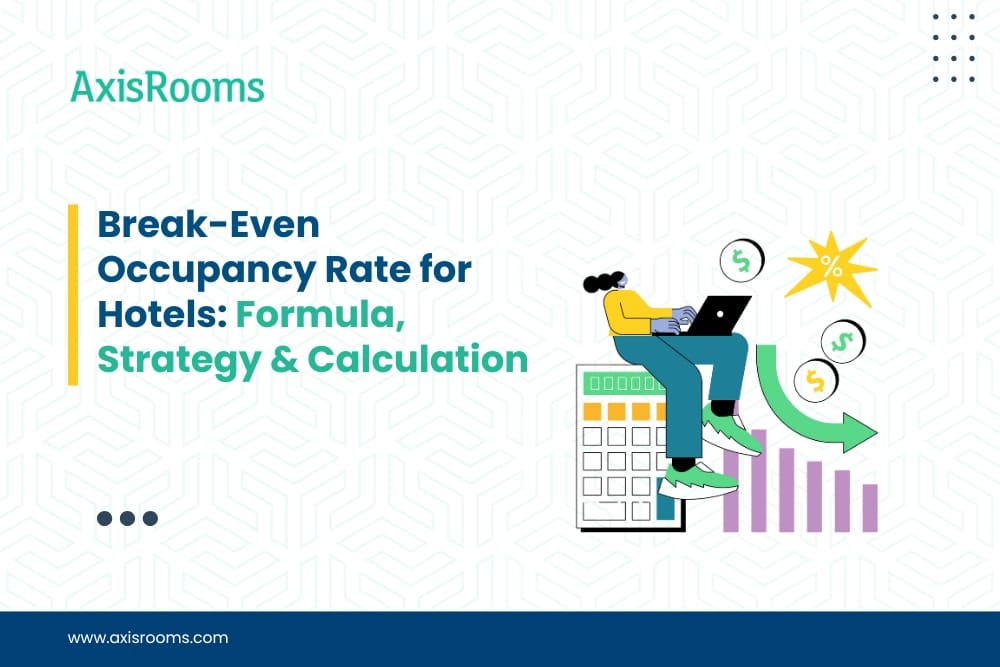Managing hotel profitability isn’t just about selling rooms — it’s about knowing how many rooms must be sold to stay in business. In today’s competitive and seasonal hotel market, understanding your break-even occupancy rate (BEOR) can help you run a leaner, more profitable operation.
This guide is tailored for hoteliers and revenue managers, with a focus on practical application, real-world formulas, and modern revenue management solutions.
What is the Break-Even Occupancy Rate in Hotels?
The break-even occupancy rate is the minimum percentage of your available rooms that must be sold at a given average rate to cover all operational costs — including fixed and variable expenses.
If you don’t reach this occupancy level, your hotel is losing money. Once you cross this threshold, every additional room sold contributes directly to profit.
Industry Insight (2025): While the global average hotel occupancy stands at 65-70%, successful hotel operations maintain gross operating profit margins of 35-45% while managing labor costs below 35% of total revenue through strategic staffing and productivity optimization.
Why It Matters for Hoteliers
In real hotel operations, revenue can fluctuate by season, market events, guest behavior, and competition. Knowing your BEOR helps you:
- Set minimum acceptable occupancy goals
- Plan for low-season strategies
- Make informed decisions on promotions and discounting
- Optimize operations by controlling costs
Understanding Your Hotel's Cost Structure
Before diving into the formula, let’s break down the costs every hotelier should know.
By clearly identifying and separating these costs, you can calculate your contribution margin per room, which is a crucial part of your BEOR.
Step-by-Step: How to Calculate Break-Even Occupancy Rate

Here’s how hoteliers can work through the calculation with clarity:
1. Determine Annual Room Availability
This is the total number of rooms you can sell in a year.
Example: A 100-room hotel open all year 100 × 365 = 36,500 room nights
2. Calculate Contribution Margin Per Room
This tells you how much each sold room contributes to covering fixed costs.
If your average rate is $120 and variable cost per room is $30: Contribution Margin = $120 – $30 = $90
3. Compute Break-Even Point in Rooms
Divide your total fixed costs by the contribution margin.
If your annual fixed costs are $900,000: Break-Even Rooms = $900,000 ÷ $90 = 10,000 rooms
4. Calculate Break-Even Occupancy Rate (BEOR)
Finally, divide the break-even rooms by your annual room availability and multiply by 100.
BEOR = (10,000 ÷ 36,500) × 100 = 27.4%
Break-Even Occupancy Rate Summary Table
How to Improve Your Break-Even Occupancy Rate

Reducing your BEOR increases the chance of operating profitably at lower occupancy. Here are proven hospitality strategies:
1. Manage Costs Smartly
- Negotiate vendor contracts and reduce unnecessary subscriptions.
- Optimize housekeeping schedules based on forecasted occupancy.
- Train cross-functional teams to handle multiple roles.
2025 Industry Trend: Labor costs typically represent 30-40% of total hotel expenses. Leading properties are implementing cross-training and strategic scheduling to maintain quality service while optimizing this significant cost center.
2. Implement Seasonal Pricing
Adopt a flexible pricing model that adapts to demand fluctuations. Use low-rate packages only when necessary to avoid rate dilution.
3. Increase High-Margin Sales
- Upsell room categories and late checkouts
- Offer in-room add-ons (e.g., minibars, spa packages)
- Monetize early check-ins or parking
4. Use Revenue Management Technology
Tools like AxisRooms Revenue Management System help automate pricing decisions based on live demand data, seasonality, competitor rates, and more.
Leverage Dynamic Pricing to Maintain Profitability
This is where the Dynamic Pricing Engine by AxisRooms becomes essential.
AxisRooms Revenue Management System offers a fully automated, AI-powered pricing tool that adjusts your room rates dynamically, 24/7. It considers factors like booking window, day of the week, seasonality, local events, and competitor rates — helping you sell rooms at the right price to maintain profitability without compromising occupancy.
Its seamless PMS integrations also ensure that pricing updates reflect across all systems instantly, reducing manual errors and saving valuable time for revenue and front desk teams.
Key Benefits:
- Keep your pricing aligned with your break-even targets
- Respond instantly to market fluctuations without manual effort
- Avoid underpricing during high-demand periods and overpricing in low demand
When paired with a well-aligned hotel marketing strategy, this dynamic pricing approach allows hoteliers to attract the right guests, during the right seasons, at the right price.
By leveraging AxisRooms’ Dynamic Pricing, hoteliers can confidently manage occupancy while protecting profit margins — exactly what break-even strategies are built to achieve.
Conclusion: Make Break-Even a Baseline, Not a Goal
Reaching your break-even occupancy rate is not the end — it’s your baseline for stability. Real success starts when your strategies consistently push you above the break-even point and into profitability.
With the right cost controls, a clear understanding of your margins, and an intelligent revenue management solution, you can build a resilient, revenue-positive hotel operation year-round.


